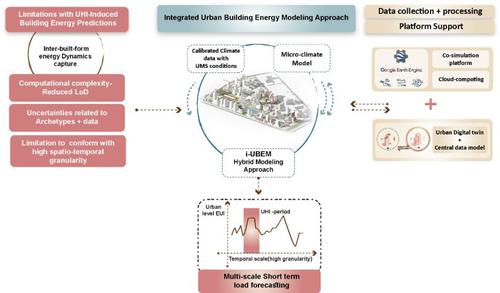Building Simulation ( IF 5.5 ) Pub Date : 2024-03-11 , DOI: 10.1007/s12273-024-1112-y Nilabhra Mondal , Prashant Anand , Ansar Khan , Chirag Deb , David Cheong , Chandra Sekhar , Dev Niyogi , Mattheos Santamouris

|
Energy demand fluctuations due to low probability high impact (LPHI) micro-climatic events such as urban heat island effect (UHI) and heatwaves, pose significant challenges for urban infrastructure, particularly within urban built-clusters. Mapping short term load forecasting (STLF) of buildings in urban micro-climatic setting (UMS) is obscured by the complex interplay of surrounding morphology, micro-climate and inter-building energy dynamics. Conventional urban building energy modelling (UBEM) approaches to provide quantitative insights about building energy consumption often neglect the synergistic impacts of micro-climate and urban morphology in short temporal scale. Reduced order modelling, unavailability of rich urban datasets such as building key performance indicators for building archetypes-characterization, limit the inter-building energy dynamics consideration into UBEMs. In addition, mismatch of resolutions of spatio–temporal datasets (meso to micro scale transition), LPHI events extent prediction around UMS as well as its accurate quantitative inclusion in UBEM input organization step pose another degree of limitations. This review aims to direct attention towards an integrated-UBEM (i-UBEM) framework to capture the building load fluctuation over multi-scale spatio–temporal scenario. It highlights usage of emerging data-driven hybrid approaches, after systematically analysing developments and limitations of recent physical, data-driven artificial intelligence and machine learning (AI-ML) based modelling approaches. It also discusses the potential integration of google earth engine (GEE)-cloud computing platform in UBEM input organization step to (i) map the land surface temperature (LST) data (quantitative attribute implying LPHI event occurrence), (ii) manage and pre-process high-resolution spatio–temporal UBEM input-datasets. Further the potential of digital twin, central structed data models to integrate along UBEM workflow to reduce uncertainties related to building archetype characterizations is explored. It has also found that a trade-off between high-fidelity baseline simulation models and computationally efficient platform support or co-simulation platform integration is essential to capture LPHI induced inter-building energy dynamics.
中文翻译:

系统回顾数据驱动的城市建筑能源模型在城市酷热期间的功效:当前趋势和未来展望
城市热岛效应 (UHI) 和热浪等低概率高影响 (LPHI) 微气候事件导致的能源需求波动,给城市基础设施带来重大挑战,特别是在城市建筑群内。城市微气候环境 (UMS) 中建筑物的短期负荷预测 (STLF) 被周围形态、微气候和建筑物间能量动态的复杂相互作用所掩盖。传统的城市建筑能源建模(UBEM)方法提供有关建筑能源消耗的定量见解,通常忽略了短时间尺度内微气候和城市形态的协同影响。降阶建模、丰富的城市数据集(例如用于建筑原型表征的建筑关键绩效指标)的不可用,限制了 UBEM 中建筑间能源动态的考虑。此外,时空数据集分辨率不匹配(中观到微观尺度转变)、UMS 周围的 LPHI 事件范围预测及其在 UBEM 输入组织步骤中的准确定量包含构成了另一个程度的限制。本综述旨在将注意力集中在集成 UBEM (i-UBEM) 框架上,以捕获多尺度时空场景下的建筑荷载波动。在系统分析了最新物理、数据驱动的人工智能和基于机器学习 (AI-ML) 的建模方法的发展和局限性之后,它强调了新兴数据驱动的混合方法的使用。它还讨论了谷歌地球引擎(GEE)-云计算平台在 UBEM 输入组织步骤中的潜在集成,以(i)绘制地表温度(LST)数据(暗示 LPHI 事件发生的定量属性),(ii)管理和预-处理高分辨率时空 UBEM 输入数据集。此外,还探讨了数字孪生、中央结构化数据模型与 UBEM 工作流程集成的潜力,以减少与构建原型表征相关的不确定性。它还发现,高保真基线仿真模型与计算高效的平台支持或协同仿真平台集成之间的权衡对于捕获 LPHI 引起的建筑物间能源动态至关重要。



























 京公网安备 11010802027423号
京公网安备 11010802027423号